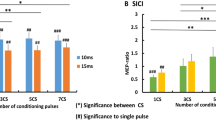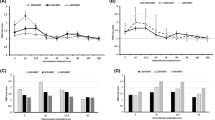Abstract
Recently, low-frequency multi-train stimulation (MTS) was shown to effectively enhance transcranial motor-evoked potentials (TcMEPs). In contrast, high- frequency double-train stimulation was reported to elicit a marked facilitation. The aim of this study was to evaluate the efficacy of high-frequency MTS in the augmentation of potentials. In addition, we investigated the safety of high-frequency MTS, behaviorally and histologically. TcMEPs were recorded from the triceps surae muscle in 38 rats. A multipulse stimulus was delivered repeatedly at different rates (2, 5, 10, 20, and 50 Hz), and was defined as MTS. A conditioned taste aversion method was used to investigate the effect of high-frequency MTS on learning and memory function. Subsequently, animals were sacrificed, and the brains were removed and examined using the standard hematoxylin-eosin method. Compared with conventional single train stimulation, TcMEP amplitudes increased 1.3, 2.1, 1.9, and 2.0 times on average with 5, 10, 20, and 50 Hz stimulation, respectively. The aversion index was >0.8 in all animals after they received 100 high-frequency MTSs. Histologically, no pathological changes were evident in the rat brains. High-frequency MTS shows potential to effectively enhance TcMEP responses, and to be used safely in transcranial brain stimulation.



Similar content being viewed by others
References
Kothbauer K, Deletis V, Epstein FJ. Intraoperative spinal cord monitoring for intramedullary surgery: an essential adjunct. Pediatr Neurosurg. 1997;26:247–54.
Cioni B, Meglio M, Rossi GF. Intraoperative motor evoked potentials monitoring in spinal neurosurgery. Arch Ital Biol. 1999;137:115–26.
Meylaerts SA, Jacobs MJ, van Iterson V, De Haan P, Kalkman CJ. Comparison of transcranial motor evoked potentials and somatosensory evoked potentials during thoracoabdominal aortic aneurysm repair. Ann Surg. 1999;230:742–9.
Kombos T, Suess O, Ciklatekerlio O, Brock M. Monitoring of intraoperative motor evoked potentials to increase the safety of surgery in and around the motor cortex. J Neurosurg. 2001;95:608–14.
Langeloo DD, Lelivelt A, Louis JH, Slappendel R, de Kleuver M. Transcranial electrical motor-evoked potential monitoring during surgery for spinal deformity: a study of 145 patients. Spine. 2003;28:1043–50 (Phila Pa 1976).
Hilibrand AS, Schwartz DM, Sethuraman V, Vaccaro AR, Albert TJ. Comparison of transcranial electric motor and somatosensory evoked potential monitoring during cervical spine surgery. J Bone Joint Surg Am. 2004;86:1248–53.
Calancie B, Molano MR. Alarm criteria for motor-evoked potentials. What’s wrong with the ‘‘presence-or-absence’’ approach? Spine. 2008;33:406–14 (Phila Pa 1976).
Sakaki K, Kawabata S, Ukegawa D, Hirai T, Ishii S, Tomori M, et al. Warning thresholds on the basis of origin of amplitude changes in transcranial electrical motor-evoked potential monitoring for cervical compression myelopathy. Spine. 2012;37:E913–21 (Phila Pa 1976).
Muramoto A, Imagama S, Ito Z, Wakao N, Ando K, Tauchi R, et al. The cutoff amplitude of transcranial motor-evoked potentials for predicting postoperative motor deficits in thoracic spine surgery. Spine. 2013;38:E21–7 (Phila Pa 1976).
Woodforth IJ, Hicks RG, Crawford MR, Stephen JP, Burke DJ. Variability of motor-evoked potentials recording during nitrous oxide anesthesia from the tibialis anterior muscle after transcranial electrical stimulation. Anesth Analg. 1996;82:744–9.
Tsutsui S, Yamada H, Hashizume H, Minamide A, Nakagawa Y, Iwasaki H, et al. Quantification of the proportion of motor neurons recruited by transcranial electrical stimulation during intraoperative motor evoked potential monitoring. J Clin Monit Comput. 2013;27:633–7.
Andersson G, Ohlin A. Spatial facilitation of motor evoked responses in monitoring during spinal surgery. Clin Neurophysiol. 1999;110:720–4.
Journée HL, Polak HE, de Kleuver M, Langeloo DD, Postma AA. Improved neuromonitoring during spinal surgery using doubletrain transcranial electrical stimulation. Med Biol Eng Comput. 2004;42:110–3.
Kakimoto M, Kawaguchi M, Yamamoto Y, Inoue S, Horiuchi T, Nakase H, et al. Tetanic stimulation of the peripheral nerve before transcranial electrical stimulation can enlarge amplitudes of myogenic motor evoked potentials during general anesthesia with neuromuscular blockade. Anesthesiology. 2005;102:733–8.
Frei FJ, Ryhult SE, Duitmann E, Hasler CC, Luetschg J, Erb TO. Intraoperative monitoring of motor evoked potentials in children undergoing spinal surgery. Spine. 2007;32:911–7 (Phila Pa 1976).
Hayashi H, Kawaguchi M, Yamamoto Y, Inoue S, Koizumi M, Ueda Y, et al. Evaluation of reliability of posttetanic motor evoked potential monitoring during spinal surgery under general anesthesia. Spine. 2008;33:E994–1000 (Phila Pa 1976).
Deletis V. Intraoperative neurophysiology and methodologies used to monitor the functional integrity of the motor system. In: Deletis V, Shils JL, editors. Neurophysiology in neurosurgery. New York: Academic Press; 2002. p. 25–51.
MacDonald DB, Al Zayed Z, Khoudeir I, Stigsby B. Monitoring scoliosis surgery with combined multiple pulse transcranial electric motor and cortical somatosensory-evoked potentials from the lower and upper extremities. Spine. 2003;28:194–203 (Phila Pa 1976).
MacDonald DB, Al Zayed Z, Al Saddigi A. Four-limb muscle motor evoked potential and optimized somatosensory evoked potential monitoring with decussation assessment: results in 206 thoracolumbar spine surgeries. Eur Spine J. 2007;16(Suppl 2):171–87.
Deletis V, Sala F. Corticospinal tract monitoring with D- and I-waves from the spinal cord and muscle MEPs from limb muscles. In: Nuwer MR, editor. Intraoperative monitoring of neural function. Handbook of clinical neurophysiology, vol. 8. Amsterdam: Elsevier; 2008. p. 235–51.
MacDonald DB, Skinner S, Shils J, Yingling C. Intraoperative motor evoked potential monitoring—a position statement by the American society of neurophysiological monitoring. Clin Neurophysiol. 2013;124:2291–316.
Tsutsui S, Iwasaki H, Yamada H, Hashizume H, Minamide A, Nakagawa Y, et al. Augmentation of motor evoked potentials using multi-train transcranial stimulation in intraoperative neurophysiologic monitoring during spinal surgery. J Clin Monit Comput. 2015;29:35–9.
MacDonald DB. Safety of intraoperative transcranial electrical stimulation motor evoked potential monitoring. J Clin Neurophysiol. 2002;19:416–29.
Chambers KC. A neural model for conditioned taste aversions. Annu Rev Neurosci. 1990;13:373–85.
Bures J, Bermudez-Rattoni F, Yamamoto T, editors. Conditioned taste aversion: memory of special kind. New York: Oxford University Press; 1998.
Barker LM, Best MR, Domjam M. Learning Mechanisms in Food Selection. Waco: Baylor University Press; 1999.
Shaw N. Disruption of conditioned taste aversion: evidence that ECS weakens the gustatory engram. Behav Neural Biol. 1988;49:302–9.
King JW, Yarita M, Yamamoto T, Matsumiya Y. Memory for conditioned taste aversion is diminished by transcranial magnetic stimulation. Physiol Behav. 1990;48:713–7.
Alstermark B, Isa T, Okki Y, Saito Y. Disynaptic pyramidal excitation in forelimb motoneurons mediated via C3–C4 propriospinal neurons in the Macaca fuscata. J Neurophysiol. 1999;82:3580–5.
Alstermark B, Ogawa J, Isa T. Lack of monosynaptic corticomotoneuronal EPSPs in rats: disynaptic EPSPs mediated via reticulospinal neurons and polysynaptic EPSPs via segmental interneurons. J Neurophysiol. 2004;91:1832–9.
Penfield W, Boldrey E. Somatic motor and sensory representation in the cerebral cortex of man as studied by electrical stimulation. Brain. 1937;60:339–443.
Marangell LB, Silver JM, Yudofsky SC. Psychopharmacology and electroconvulsive therapy. In: Hales RE, Yudofsky SC, Talbot JA, editors. The American psychiatric press textbook of psychiatry. 3rd ed. American psychiatric press; 1999. p. 1025–9.
Wasserman EM. Risk and safety of repetitive transcranial magnetic stimulation: report and suggested guidelines from the International Workshop on the safety of repetitive transcranial magnetic stimulation. Electroencephalogr Clin Neurophysiol. 1998;108:1–16.
Stenberg J, Levy D, Zangen A. Impairment of aversive memory reconsolidation by localized intracranial electrical stimulation. Eur J Neurosci. 2009;29:964–9.
Hemmer LB, Zeeni C, Bebawy JF, Bendok BR, Cotton MA, Shah NB, et al. The incidence of unacceptable movement with motor evoked potentials during craniotomy for anuerysm clipping. World Neurosurg. 2014;81:99–104.
Acknowledgments
This study was supported by Grants-in-Aid for Scientific Research in the Japanese Society for the Promotion of Science (KAKENHI; 26462248).
Funding
This study was funded by Grants-in-Aid for Scientific Research in the Japanese Society for the Promotion of Science (KAKENHI; 26462248).
Author information
Authors and Affiliations
Corresponding author
Ethics declarations
Conflict of interest
The authors declare that they have no conflict of interest.
Ethical standards
All applicable international, national, and institutional guidelines for the care and use of animals were followed.
Rights and permissions
About this article
Cite this article
Deguchi, T., Tsutsui, S., Iwahashi, H. et al. Efficacy and safety of novel high-frequency multi-train stimulation for recording transcranial motor evoked potentials in a rat model. J Clin Monit Comput 31, 1053–1058 (2017). https://doi.org/10.1007/s10877-016-9930-9
Received:
Accepted:
Published:
Issue Date:
DOI: https://doi.org/10.1007/s10877-016-9930-9




